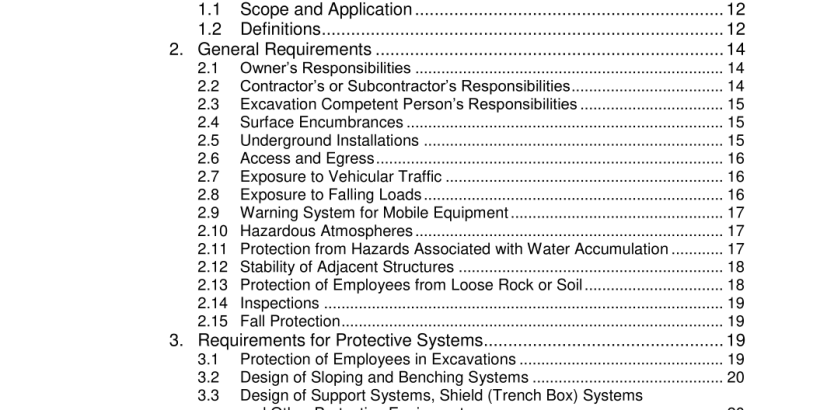ANSI ASSP A10.12-1998 pdf download.Safety Requirements for Excavation
1.2.12 Excavation Competent Person. One who has received training and can demonstrate knowledge, skills and abilities to fulfill the duties required by this standard and who is capable of identifying existing and predictable hazards in the surroundings or working conditions that are unsanitary, hazardous or dangerous to employees, and who has the authorization and the responsibility to take prompt corrective measures to eliminate or control the hazards and conditions.
1.2.13 Excavation Safety and Health Plan. The written safety and health plan developed by the contractor for the excava- tion work that describes the requirements and procedures to be implemented. See Section 2.
1.2.14 Faces. The vertical or inclined earth surfaces formed as a result of excavation work. 1.2.15 Failure. The breakage, displace- ment or permanent deformation of a structural member, mass, component or connection so as to reduce the structural integrity and/or the supportive capabilities of the worker-protection system.
1.2.16 Hazardous Atmosphere. An atmosphere that (by reason of being explosive, flammable, poisonous, corrosive, oxidizing, irritating, oxygen deficient, toxic or otherwise harmful), may cause death, illness or injury.
1.2.19 Protective System. Method employed by the contractor to protect employees from cave-ins, from material falling or rolling into an excavation, or from the collapse of adjacent structures. Protective systems include support systems, sloping and benching systems, shield (trench box) systems and other systems that provide the necessary protection.
1.2.20 Ramp. An inclined walking or working surface that is used to gain access to one point from another, and is constructed from earth or from structural materials such as steel or wood.
1.2.21 Registered Professional Engi- neer. A person who is licensed as a professional engineer in the state where the work is to be performed. However, a professional engineer licensed in any state is deemed to be a registered professional engineer within the meaning of this standard when approving designs for manufactured protective systems or tabulated data to be used in interstate commerce.
1.2.22 Sheeting. The members of a shor- ing system that retain the earth in position and in turn are supported by other members of the shoring sister. Sheeting is 2- or 3-inch or thicker dimension lumber as specified in Appendixes C and D or manufactured members of equivalent strength.
1.2.23 Shield or Trench Box (Shield System). A structure that is able to withstand the forces imposed on it by a cave-in and thereby protect employees within the structure. Shields can be perma- nent structures or can be designed to be portable and moved along as work progresses. Additionally, shields can be either pre-manufactured or job-built in accordance with Sections 3.3.3 or 3.3.4. Shields used in trenches are usually referred to as trench boxes or trench shields.
2.6.2 Means of access to and egress from trench excavations. A stairway, ladder (meeting recognized industry standards), ramp or other safe means of access and egress shall be located in trench excava- tions that are 4 feet (1 .22m) or more in depth so as to require no more than 25 feet (7.62m) of lateral travel for employees. Side rails of the ladder shall extend not less than 3 feet (0.91 m) above the landing or surface of the ground, whichever is greater. Ladders shall be tied, blocked or otherwise secured to prevent being displaced. Ramps may be considered a safe means of egress only if employees are able to walk the ramp in an upright manner when entering or exiting the trench.
2.7 Exposure to Vehicular Traffic. Employees exposed to public vehicular traffic shall be provided with, and shall wear, warning vests or other suitable garments recognized by the industry as safety cloth- ing marked with or made of reflectorized or high-visibility material.
2.8 Exposure to Falling Loads. No employee shall be permitted underneath loads handled by lifting or digging equip- ment. Employees shall be required to stand away from any vehicle being loaded or unloaded to avoid being struck by any spillage or falling materials. Operators may remain in the cabs of vehicles being loaded or unloaded when the vehicles are equipped to provide adequate protection for the operator during loading and unloading operations. ANSI ASSP A10.12-1998 pdf download
